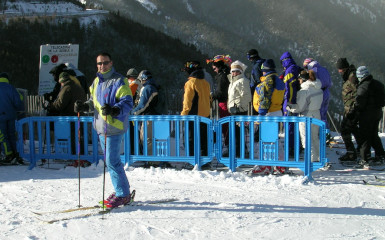While on the slopes, skiers and snowboarders can reach some very high speeds. Because of this, they must often make snap judgments about which paths they will take on the trails. When trails are crowded, making the right decisions becomes even more paramount. Accidents occur when skiers don’t react quickly enough, or when hazards and other obstructions aren’t seen.
Why High Visibility Barriers Are Necessary
In some ways, the slopes are similar to a highway. Drivers rely on signs to direct them and, due to the speeds cars are moving at, multiple signs and bright colors are often used. For example, if a lane is closed due to construction, bright and colorful signs are placed well in advance with clear instructions printed on them. This allows drivers to slow down, change lanes, and prepare for what lies ahead.
Similar tactics should be used on the slopes for skiers and snowboarders. Hazardous areas will pop up from time to time, and properly warning those on the trails is essential to preventing accidents. The same goes for obstructions – like man-made hoses or pipes – that can get tangled or caught on skis or snowboards. Failing to properly document and block off obstructions could lead to a lawsuit if someone gets injured, and that could financially cripple a resort.
The Benefits of High Visibility Barriers
Steel barriers and their corresponding high visibility covers benefit resorts in a variety of ways, plus they can be used for multiple purposes. Steel barriers are most commonly used to direct traffic, and barrier covers ensure that they are seen by any passing visitors. These barriers are very valuable on the slopes because they can direct traffic away from hazardous or restricted areas, and they can warn skiers and snowboarders of obstructions.
Steel barriers are lightweight, yet durable, making them the ideal solution for restricting access on the mountain. Steel barriers also have the ability to interlock, so staff can easily set up a barrier around a hazardous area or block off access to a trail completely. However, steel barriers alone might not be enough to alert skiers and snowboarders to potential dangers.
Barrier covers can be used in conjunction with hook and loop signs to create high visibility barriers that give skiers an obvious warning of danger. Barrier covers come in solid colors and cover the entirety of the barricade, creating a large and easy to see notice of what lies ahead. Hook and loop signs are paired with these covers to provide necessary information to those traveling down the slope. These signs can give simple directional warnings or more specific information, and they can be easily changed to ensure the slopes are always up to date.
The Bottom Line
Accidents will always be a part of skiing and snowboarding, but there are many things that have and will be done to ensure every resort visitor is as safe as can be. Even when resorts use high visibility barriers, safety is not guaranteed. If the barriers aren’t utilized properly or aren’t up to date, accidents might occur. If new hazards and obstructions are not first identified by staff, the resort runs the risk of having a visitor accidentally making the discovery. Every ski resort should have a list of best safety practices that can be followed on a weekly, monthly, and yearly basis. Thinking problems through and being proactive are two of the most important aspects of running a safe operation.
Steel barriers and barrier covers can also have other benefits for a ski resort. Barriers can be used to direct visitors as they queue for the ski lift, or they can be used in conjunction with the covers during events to inform visitors and restrict access. High visibility barriers are very valuable and flexible assets for resorts, but their use for safety can never be overstated.

